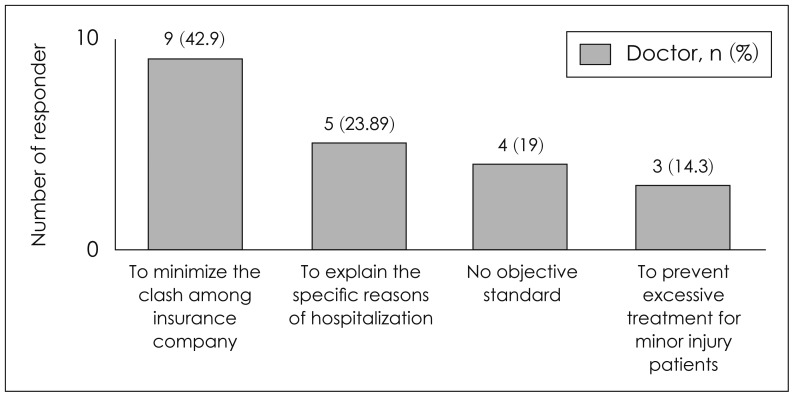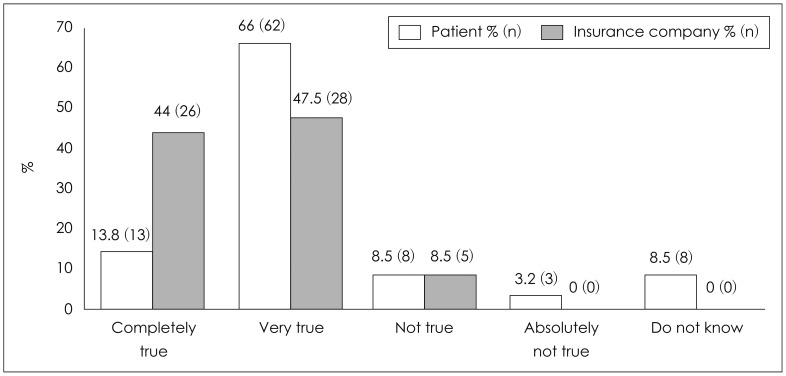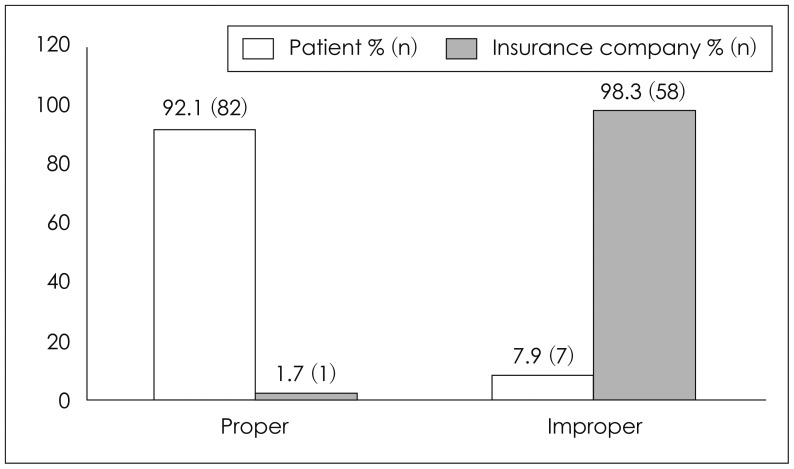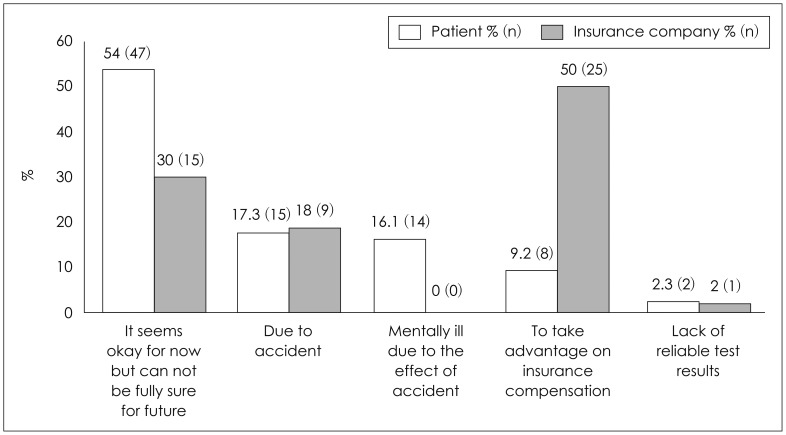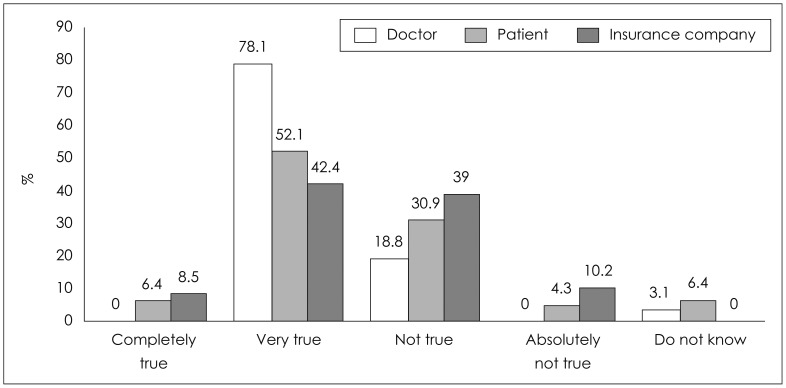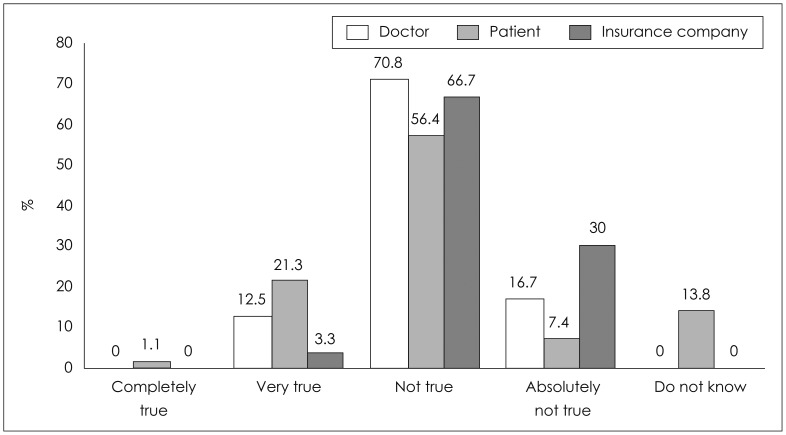Korean J Neurotrauma.
2014 Oct;10(2):92-100. 10.13004/kjnt.2014.10.2.92.
An Evaluation of the Government's Current Guideline on the Hospitalization of Minor Head Trauma Patients
- Affiliations
-
- 1Department of Neurosurgery, Gachon University Gil Medical Center, Incheon, Korea. nschan@gilhospital.com
- KMID: 2256240
- DOI: http://doi.org/10.13004/kjnt.2014.10.2.92
Abstract
OBJECTIVE
In June 28, 2012, a 'Hospitalization guideline for car accident patients' was announced to mediate the clash of opinions about the hospitalization of minor head trauma patients among doctors, patients and insurance companies. The guideline was issued to describe the patients' symptoms and emotions in detail after the injury. In this paper, evaluation for the guideline and suggestions for modifications was done.
METHODS
Thirty-two doctors, 96 patients and 60 employees were each given surveys about the hospitalization guidelines, related personnels' attitude and evaluation of patients' emotional problems. The frequency, ratio and chi-square test were performed.
RESULTS
Sixty-eight point eight percent of doctors, 79.8% patients and 91.6% insurance company employees agreed to the need for a guideline. Among the 68.8% doctors that supported the need for a guideline, 18.8% knew that the guideline actually existed. Sixty-nine point two percent of doctors said that they would apply the guideline once they were introduced to it. Among the announced guideline provisions, 'Glasgow coma score less than 15' and 'socially not suitable for discharge' required reevaluation since 40.6% all surveyors consented that these two criteria were not suitable. The consensus supporting the need for emotional evaluation came out to be 78.1%, 58.5%, 50.9% in doctors, patients and insurance employees respectively.
CONCLUSION
Although a guideline for hospitalization of minor head injury patients is necessary, some part of it seems to be reevaluated and improved, especially for clauses related to the patient's emotional problems. These changes and revisions to the guideline require further speculation and research.
Keyword
Figure
Reference
-
1. Baines P. NICE head injury guidelines review of the legal mandate. Emerg Med J. 2005; 22:706–709. PMID: 16189032.
Article2. Barbosa RR, Jawa R, Watters JM, Knight JC, Kerwin AJ, Winston ES, et al. Evaluation and management of mild traumatic brain injury: an Eastern Association for the Surgery of Trauma practice management guideline. J Trauma Acute Care Surg. 2012; 73(5 Suppl 4):S307–S314. PMID: 23114486.3. Borg J, Holm L, Cassidy JD, Peloso PM, Carroll LJ, von Holst H, et al. Diagnostic procedures in mild traumatic brain injury results of the WHO Collaborating Centre Task Force on Mild Traumatic Brain Injury. J Rehabil Med. 2004; (43 Suppl):61–75. PMID: 15083871.
Article4. Cushman JG, Agarwal N, Fabian TC, Garcia V, Nagy KK, Pasquale MD, et al. Practice management guidelines for the management of mild traumatic brain injury the EAST practice management guidelines work group. J Trauma. 2001; 51:1016–1026. PMID: 11706358.
Article5. Lee JH, Kim JE. Comparisons and implications of leading countries' regulation system related to high admission rate of car accident patients. Seoul: Korea Insurance Research Institute;2010.6. Ministry of Land, Transport and Maritime Affairs. Hospitalization guideline for car accident patients. Sejong: Ministry of Land, Transport, and Maritime Affairs;2012.7. Ministry of Land, Transport and Maritime Affairs. The Catholic University of Korea Industry-Academic Cooperation Foundation. A study on the basic research of improving car insurance health care delivery system: centered on the patient hospitalization and outpatient guide. Gwacheon: Ministry of Land, Transport and Maritime Affairs;2011.8. Motor Accidents Authority NSW. Guidelines for mild traumatic brain injury following closed head injury. Sydney, AU: Ambulance Service of New South Wales;2008.9. National Collaborating Centre for Acute Care. Head injury: triage, assessment, investigation and early management of head injury in infants, children and adults. London, UK: National Collaborating Centre for Acute Care;2007. 9. NICE Clinical Guidelines, No. 56.10. Song YA. Improvement point and explanation for admission rate of car accident patients. Seoul: Korea Insurance Research Institute;2010.11. Stavrinides V. Head injury admissions at a district general hospital: adherence to NICE guidelines. Online J Clin Audits. 2010. 2:Stavrinides.12. The Korean Neurosurgical Society. Neurosurgery. ed 3. Seoul: Korea Medical Book Publisher;2005.13. Vos PE, Battistin L, Birbamer G, Gerstenbrand F, Potapov A, Prevec T, et al. EFNS guideline on mild traumatic brain injury report of an EFNS task force. Eur J Neurol. 2002; 9:207–219. PMID: 11985628.
Article14. Yang DS. Present conditions and problems of automobile insurance victims admission. General Insurance. 2007; 468:14–24.
- Full Text Links
- Actions
-
Cited
- CITED
-
- Close
- Share
- Similar articles
-
- Hemorrhagic Cerebral Metastases from Hepatocellular Carcinoma: Presumptive Role of Minor Head Trauma
- Usefulness of the Base Deficit as an Injury-severity Indicator in Multiple-trauma Patients with Head Injuries
- Necessity of developing a disability evaluation guideline
- Does Serum Osmolarity Change as a Result of the Reflex Neuroprotective Mechanism of Cerebral Osmo-Regulation after Minor Head Trauma?
- A consideration for legal proceedings about mental evaluation: For the evaluation of disabilty due to mental disorders after head trauma caused by car accidents etc.

